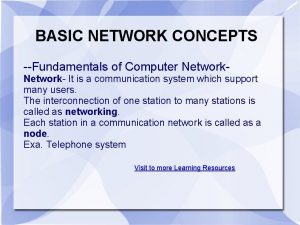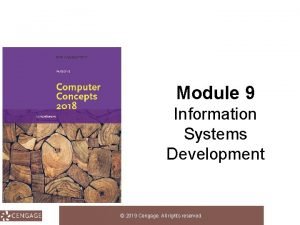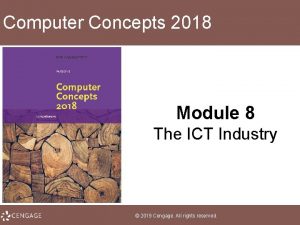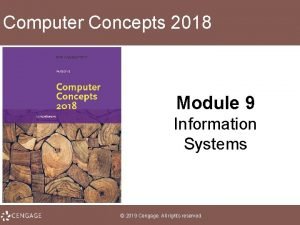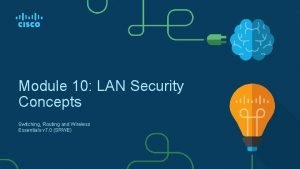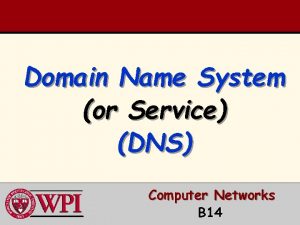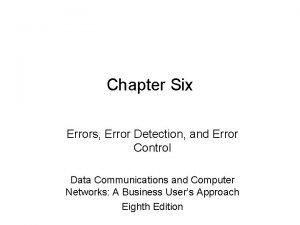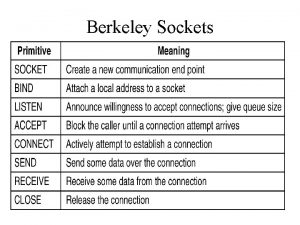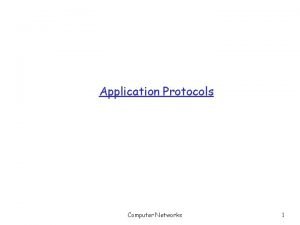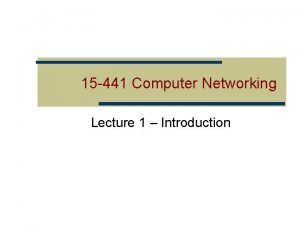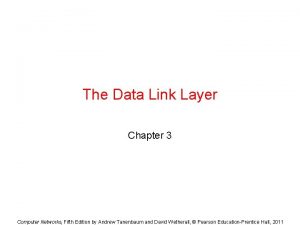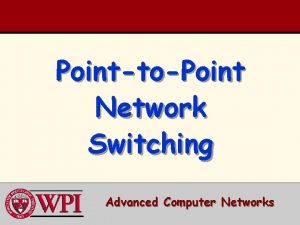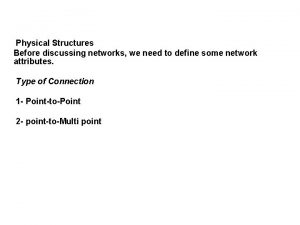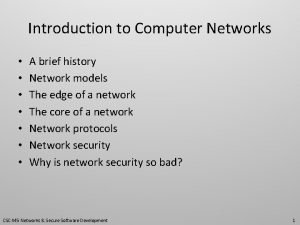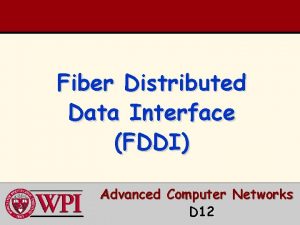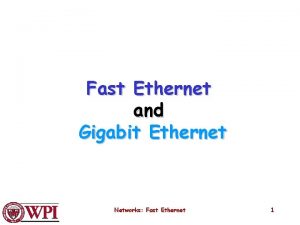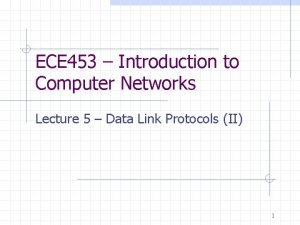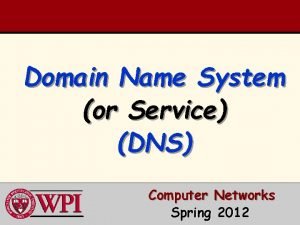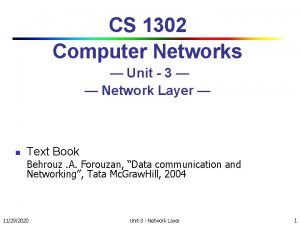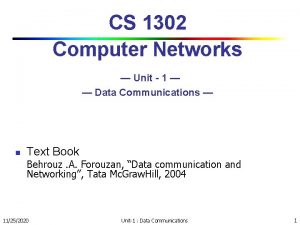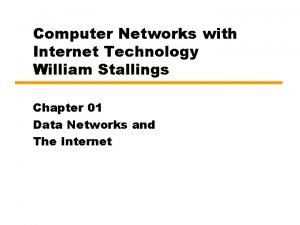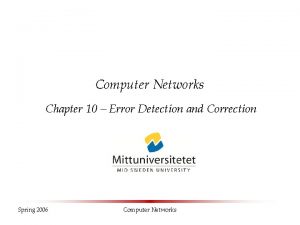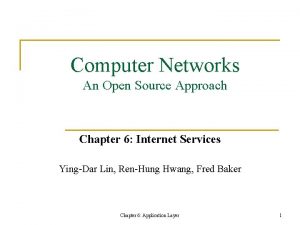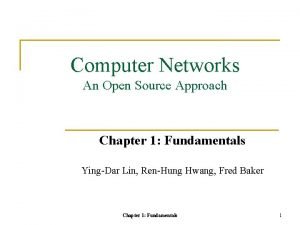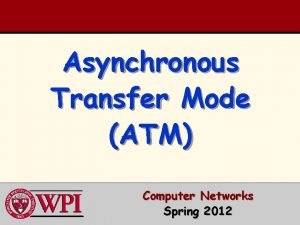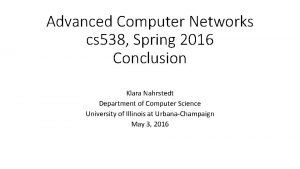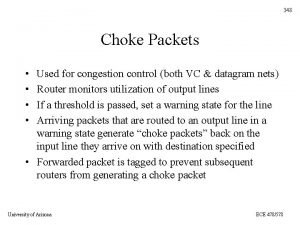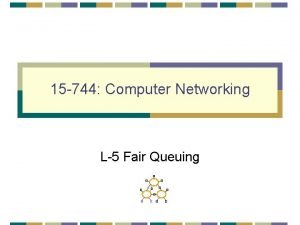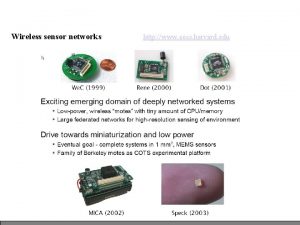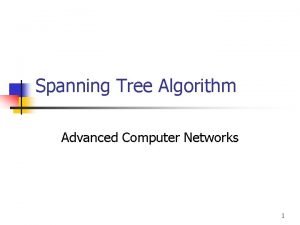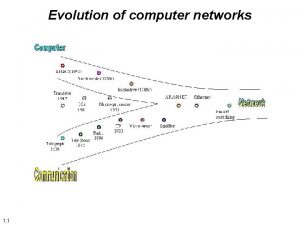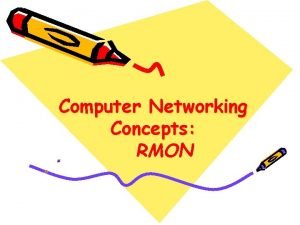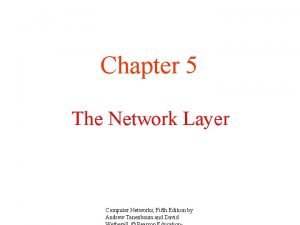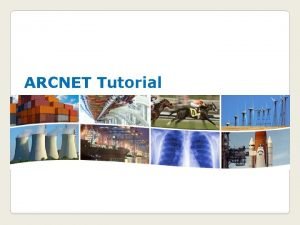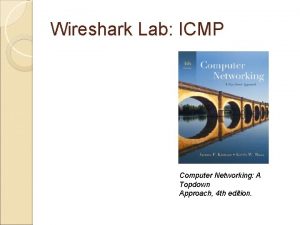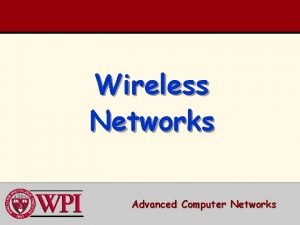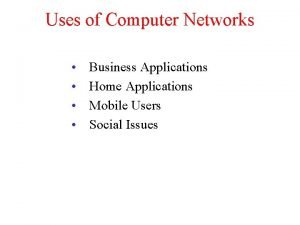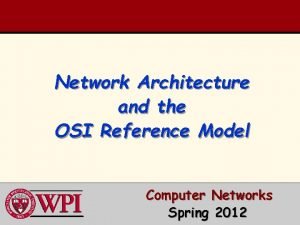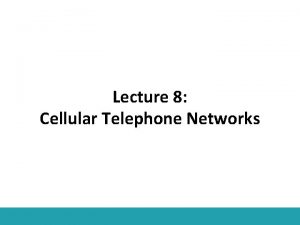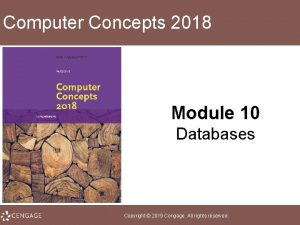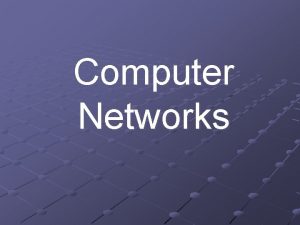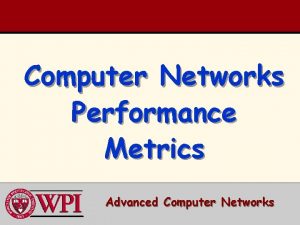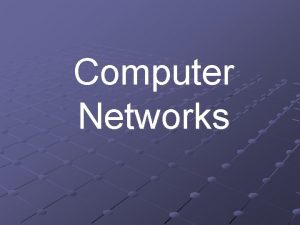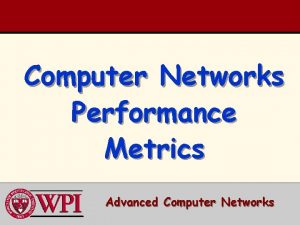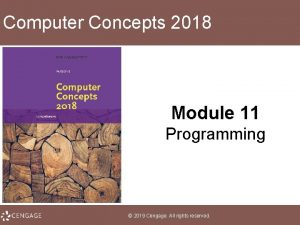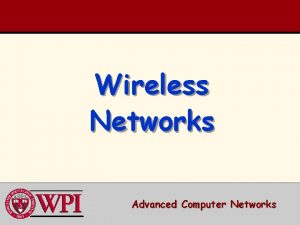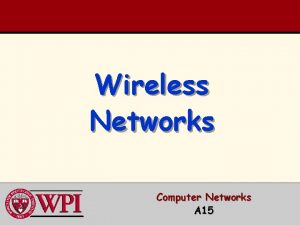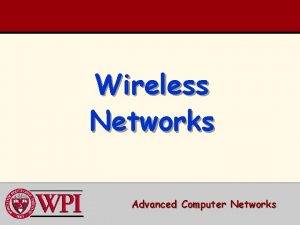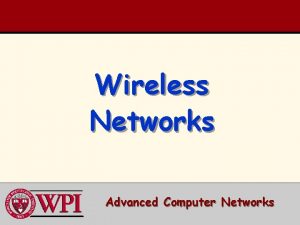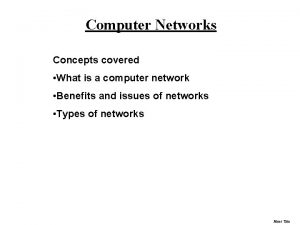Computer Concepts 2018 Module 3 Networks Copyright 2019































































































- Slides: 95

Computer Concepts 2018 Module 3 Networks Copyright © 2019 Cengage. All rights reserved.

Module Contents • • • Section A: Network Basics Section B: The Internet Section C: Internet Access Section D: Local Area Networks Section E: File Sharing Copyright © 2019 Cengage. All rights reserved.

Section A: Network Basics • • • Communication Systems Communication Channels Network Topology Network Nodes Communication Protocols Copyright © 2019 Cengage. All rights reserved.

Communication Systems (1 of 5) • Networks can be classified in many ways; as a network user, you’ll want to keep in mind the idea of control and how it affects your privacy and security • A network links things together • A communication network (or communication system) links together devices to data and information can be shared among them Copyright © 2019 Cengage. All rights reserved.

Communication Systems (2 of 5) • In 1948, Claude Shannon, an engineer at Bell Labs, published and article describing a communication system model applicable to networks of all types • His diagram illustrates the essence of a network Copyright © 2019 Cengage. All rights reserved.

Communication Systems (3 of 5) • Networks can be classified according to their size and geographic scope • PAN (personal area network) – PANs connect smart devices or consumer electronics within a range of about 30 feet (10 meters) and without the use of wires or cables. The reference to personal indicates that the network serves a single individual, rather than multiple users. A PAN could be used to sync data from a handheld device to a desktop computer, ship data wirelessly to a printer, or transmit data from a smartphone to a wireless headset. Copyright © 2019 Cengage. All rights reserved.

Communication Systems (4 of 5) • LAN (local area network) – LANs are data communication networks that connect personal computers within a very limited geographical area —usually a single building. School computer labs and home networks are examples of LANs. Wi-Fi networks that you can access in airports, coffee shops, and other public places are LANs. The in-house networks operated by most businesses are also LANs. Copyright © 2019 Cengage. All rights reserved.

Communication Systems (5 of 5) • WAN (wide area network) – WANs cover a large geographical area and usually consist of several smaller networks, which might use different computer platforms and network technologies. The Internet is the world’s largest WAN. Other public WANs include telephone systems, cable television systems, and satellite based communication systems. Copyright © 2019 Cengage. All rights reserved.

Communication Channels (1 of 10) • A communication channel is the medium used to transport information from one network device to another • Wired channels transport data through wires and cables • Wireless channels transport data from one device to another without the use of cable or wires Copyright © 2019 Cengage. All rights reserved.

Communication Channels (2 of 10) • Wired channels include twisted pair wires used for telephone land lines, coaxial cables used for cable television networks, Category 6 cables used for LANs, and fiber-optic cables used for high-capacity trunk lines Copyright © 2019 Cengage. All rights reserved.

Communication Channels (3 of 10) • When you set up a wired connection, you don’t have to worry about hackers intercepting your data from outside your house • There are ways to tap into a wired network, but they require physical access to the cable or fairly sophisticated snooping equipment Copyright © 2019 Cengage. All rights reserved.

Communication Channels (4 of 10) • Cables can be shielded against interference and encased in protective casings for installations that are outdoors and underground. • Wired connections are dependable. Their carrying capacity and speed are not affected by airborne interference from rain, snow, or electrical devices. • Wired connections are more secure than their wireless counterparts because a device can join a wired network only if it is physically connected by a cable. Copyright © 2019 Cengage. All rights reserved.

Communication Channels (5 of 10) • In WANs, wired installation can be costly because cables have to be suspended from poles or buried underground. They can be damaged by weather events and digging in the wrong place. Repairs to underground cables require heavy equipment to locate, access, and fix the break. • LAN devices connected by cables have limited mobility. Desktop computers tend to be better candidates for wired connections, whereas laptops, tablets, and handheld devices can retain their mobility when they are not tethered to a cable. • Cables are unsightly, tend to get tangled, and collect dust. Running cables through ceilings, walls, and floors can be challenging. Cables can also carry electrical surges that have the potential to damage network equipment. Copyright © 2019 Cengage. All rights reserved.

Communication Channels (6 of 10) • The most widespread wireless channels for communication networks are radio signals and microwaves • Most wireless channels transport data as RF signals commonly called radio waves • RF signals are sent and received by a transceiver (a combination of a transmitter and a receiver) that is equipped with an antenna Copyright © 2019 Cengage. All rights reserved.

Communication Channels (7 of 10) Devices used with wireless connections are equipped with transceivers that include a transmitter for sending data and a receiver for collecting data. A transceiver has an antenna, which may be visible or may be housed out of sight within a device’s system unit. Copyright © 2019 Cengage. All rights reserved.

Communication Channels (8 of 10) • Microwaves (the waves themselves, not your oven!) provide another option for transporting data wirelessly • Microwaves are electromagnetic signals that can be aimed in a single direction and have more carrying capacity than radio waves • Microwave installations usually provide data transport for large corporate networks Copyright © 2019 Cengage. All rights reserved.

Communication Channels (9 of 10) • Advantages of wireless – Mobility – No unsightly cables – Less susceptible to power spikes • Disadvantages of wireless – – Speed Range Security Licensing Copyright © 2019 Cengage. All rights reserved.

Communication Channels (10 of 10) • Bandwidth is the transmission capacity of a communication channel • Network channels that are capable of moving at least 25 megabits of data per second (25 Mbps) are classified as broadband • Channels slower than 25 Mbps are classified as narrowband Copyright © 2019 Cengage. All rights reserved.

Network Topology (1 of 2) • In the context of communication networks, topology refers to the structure and layout of network components, such as computers, connecting cables, and wireless signal paths – Point-to-point topology refers to the process of peripheral devices connecting to a host device using expansion ports, USB cables, or Bluetooth – Star topology connects multiple devices to a central device – Mesh topology connects multiple devices to each other, either as a full mesh or as a partial mesh – The less popular bus topology connects devices in a linear sequence Copyright © 2019 Cengage. All rights reserved.

Network Topology (2 of 2) Copyright © 2019 Cengage. All rights reserved.

Network Nodes (1 of 3) • Any device on a network is called a node • Devices on a network are classified as DTEs or DCEs – DTE stands for data terminal equipment and can be any device that stores or generates data – DCE stands for data communication equipment; these devices control the speed of data over networks, convert signals from cables to wireless, check for corrupted data, and route data to its destination Copyright © 2019 Cengage. All rights reserved.

Network Nodes (2 of 3) • A router is a device that controls the flow of data within a network and also acts as a gateway to pass data from one network to another • A modem contains circuitry that converts the datacarrying signals from a digital device to signals that can travel over various communications channels Copyright © 2019 Cengage. All rights reserved.

Network Nodes (3 of 3) • DCEs such as repeaters, switches, and hubs can extend the range of your home network Copyright © 2019 Cengage. All rights reserved.

Communication Protocols (1 of 3) • In the context of networks, a communication protocol refers to a set of rules for efficiently transmitting data from one network node to another • This process is called handshaking • Networks use more than one protocol, and the collection of protocols for a network is referred to as a protocol stack Copyright © 2019 Cengage. All rights reserved.

Communication Protocols (2 of 3) • PHYSICAL PROTOCOLS – Specify cable and signal standards for the channels that carry data • TRANSPORT PROTOCOLS – Make sure data gets to its destination by establishing standards for dividing data into chunks, assigning addresses, and correcting errors • ARRIVAL PROTOCOLS – Convert data into standard formats that can be used by applications, such as email, Web browsers, and Skype Copyright © 2019 Cengage. All rights reserved.

Communication Protocols (3 of 3) • Error correction is one of the responsibilities of communication protocols • Digital networks—those that transmit digital signals— can be easily monitored to determine if interference has corrupted any signals Copyright © 2019 Cengage. All rights reserved.

Section B: The Internet • • • Background Internet Infrastructure Packets Internet Addresses Domain Names Copyright © 2019 Cengage. All rights reserved.

Background (1 of 5) • The history of the Internet begins in 1957 • In a response to the Soviet Union launching Sputnik, the first man-made satellite, the U. S. government resolved to improve its scientific and technical infrastructure • One of the resulting initiatives was the Advanced Research Projects Agency (ARPA) Copyright © 2019 Cengage. All rights reserved.

Background (2 of 5) • ARPA designed a project to help scientists communicate and share valuable computer resources, and called The ARPANET • The ARPANET, created in 1969, connected computers at UCLA, the Stanford Research Institute, the University of Utah, and UC California at Santa Barbara Copyright © 2019 Cengage. All rights reserved.

Background (3 of 5) • Early Internet pioneers used primitive command-line user interfaces to send email, transfer files, and run scientific calculations on Internet supercomputers • In the 1990 s, software developers created new userfriendly Internet access tools, and Internet accounts became available to anyone willing to pay a monthly subscription fee Copyright © 2019 Cengage. All rights reserved.

Background (4 of 5) • Today’s Internet, with an estimated 500 million nodes and more than 3 billion users, is huge • It is estimated that the Internet handles more than two exabytes of data every day; an exabyte is 1. 074 billion gigabytes – a nearly unimaginable amount of data! Copyright © 2019 Cengage. All rights reserved.

Background (5 of 5) • In theory, no single person, organization, company, or government runs the Internet • Internet governance is simply a set of shared protocols, procedures, and technologies that evolve through common agreement among network providers • The organization that supervises internet addressing is ICANN, the Internet Corporation for Assigned Names and Numbers Copyright © 2019 Cengage. All rights reserved.

Internet Infrastructure (1 of 3) • The way networks fit together is referred to as the Internet Infrastructure • Tier 1 networks, such as AT&T, Century. Link, Verizon, and NTT Communications represent the top of the Internet hierarchy and form the Internet backbone, a system of high-capacity routers and fiber-optic communication links providing the main routes for data speeding across the Internet • Networks that form the Internet are maintained by Internet service providers (ISPs) • ISPs exchange data at Internet exchange points (IXPs) Copyright © 2019 Cengage. All rights reserved.

Internet Infrastructure (2 of 3) Copyright © 2019 Cengage. All rights reserved.

Internet Infrastructure (3 of 3) • The internet is not free; ISPs make a substantial investment in equipment and infrastructure to connect consumers • Tier 1 ISPs own and maintain millions of dollars of data communication equipment Copyright © 2019 Cengage. All rights reserved.

Packets (1 of 6) • A packet is a parcel of data that is sent across a computer network; when packets reach their destination, they are reassembled into the original message according to their sequence numbers Copyright © 2019 Cengage. All rights reserved.

Packets (2 of 6) Messages divided into equal-size packets are easier to handle than an assortment of small, medium, large, and extra large files. Copyright © 2019 Cengage. All rights reserved.

Packets (3 of 6) • Communication networks use a technology called circuit switching, which establishes a private link between one telephone and another for the duration of a call • A more efficient alterative to this process is packet switching technology, which divides a message into several packets that can be routed independently to their destination Copyright © 2019 Cengage. All rights reserved.

Packets (4 of 6) Copyright © 2019 Cengage. All rights reserved.

Packets (5 of 6) • One of the core Internet protocols, TCP (Transmission Control Protocol) is responsible for dividing files into chunks, adding headers containing information for reassembling packets in their original order, and verifying that the data was not corrupted while in transit (a process called error checking) • UDP (User Datagram Protocol) is an alternative transport protocol which is faster than a TCP but does not perform error checking and cannot reorder packets Copyright © 2019 Cengage. All rights reserved.

Packets (6 of 6) • A communication port (usually referred to simply as a port) is a virtual end point for data entering and leaving a digital device • Communication ports are not a physical circuit, but rather an abstract concept of a doorway, an opening, or a portal through which data flows Copyright © 2019 Cengage. All rights reserved.

Internet Addresses (1 of 3) • Internet Addresses are controlled by IP (Internet Protocol), which is part of the Internet protocol suite • Many devices on the Internet have permanently assigned IP addresses called static addresses • IP defines two sets of addresses: IPv 4 and IPv 6 – IPv 4 – (Internet Protocol version 4); is the Internet address standard; uses 32 -bit addresses to identify Internet connected devices – IPv 6 – (Internet Protocol version 6); uses 128 bits for each address; produces billions and billions of unique Internet addresses Copyright © 2019 Cengage. All rights reserved.

Internet Addresses (2 of 3) • Internet addresses that are temporarily assigned to a device are called dynamic addresses • IP addresses can be assigned by a network administrator, but more commonly they are automatically assigned by DHCP (Dynamic Host Configuration Protocol) • A private IP address can be allocated by any network without supervision from ICANN – but it cannot be used to send data over the Internet; it’s not routable Copyright © 2019 Cengage. All rights reserved.

Internet Addresses (3 of 3) • Because a private IP address cannot be routed over the Internet a local router connects instead • The local router has a public IP address that is routable over the Internet Copyright © 2019 Cengage. All rights reserved.

Domain Names (1 of 3) • It’s hard to remember the string of numbers in an IP address; most Internet destinations also have an easyto-remember domain name, such as nike. com • The mechanism for tracking domain names and their corresponding IP addresses is called the domain name system (DNS) • A domain name ends with an extension that indicates its top-level domain, such as. edu or. org • Domain name servers are scattered around the world and maintain lists of all domain names and their corresponding IP addresses Copyright © 2019 Cengage. All rights reserved.

Domain Names (2 of 3) Copyright © 2019 Cengage. All rights reserved.

Domain Names (3 of 3) • Altering DNS records can change the destination of email, browser connections, and download requests • Unauthorized changes to the DNS are called DNS spoofing Copyright © 2019 Cengage. All rights reserved.

Section C: Internet Access • • • Connection Basics Cable Internet Service Telephone Network Internet Service Satellite Internet Service Mobile Broadband Service Wi-Fi Hotspots Copyright © 2019 Cengage. All rights reserved.

Connection Basics (1 of 7) • Data travels over the Internet at an incredible speed, but that speed varies; some Internet services are faster than others • It is easy to check the speed of your Internet connection by running a few online tests Copyright © 2019 Cengage. All rights reserved.

Connection Basics (2 of 7) This speed test measured the rate of data flowing between the user’s ISP in Macon, GA, and a Comcast server in Moncks Corner, SC. Copyright © 2019 Cengage. All rights reserved.

Connection Basics (3 of 7) • The most common measurement of connection speed is the amount of data that can be transmitted in a specified time; technically, it is a measure of capacity SERVICE Recommended Download Recommended Upload Skype video calling and screen sharing 300 Kbps Skype video calls (HD) 1. 5 Mbps Skype three-person group calling 2 Mbps 512 Kbps Netflix movie on a laptop computer 1 Mbps Netflix SD movie on a TV 2 Mbps Netflix 720 p HD movie 4 Mbps Netflix "best video and audio experience" 5 Mbps You. Tube basic videos 500 Kbps You. Tube movies, TV shows, and live events 1 Mbps Amazon Prime Instant Video (SD) 900 Kbps Amazon Prime Instant Video (HD) 3. 5 Mbps Netflix and Amazon 4 K Streaming Video 15 -25 Mbps Copyright © 2019 Cengage. All rights reserved.

Connection Basics (4 of 7) • ISPs control connection speeds based on the service plan you’ve selected • Your bandwidth cap is the top speed allowed by your plan • During peak times, ISPs can place further limits on speed, a process called bandwidth throttling • When Internet upload speed differs from download speed, you have an asymmetric connection • When upload and download speeds are the same, you have a symmetric connection Copyright © 2019 Cengage. All rights reserved.

Connection Basics (5 of 7) • Ping is utility software designed to measure responsiveness • Ping rate indicates how quickly data can reach a server and bounce back to you • Latency is the elapsed time for data to make a roundtrip from point A to point B and back to point A • Jitter measures the variability of packet latency caused when network traffic and interference can delay packets and create erratic data flow • Packet loss refers to data that never reaches its destination or gets discarded because it arrives too late Copyright © 2019 Cengage. All rights reserved.

Connection Basics (6 of 7) • To determine whether or not your slow Internet connection is caused by your ISP or your computer you can use a Traceroute, a network diagnostic tool that lists each router and server Copyright © 2019 Cengage. All rights reserved.

Connection Basics (7 of 7) • Although public Internet access is available in many locations, such as coffee shops and libraries, most consumers like the convenience of having their own Internet connection Copyright © 2019 Cengage. All rights reserved.

Cable Internet Service (1 of 2) • The gold standard of fixed Internet access is cable Internet service, which is offered by the same companies that supply cable television • CATV stands for community antenna television • With cables branching out from a central location, the topology of a CATV system works well as the infrastructure for a digital data network Copyright © 2019 Cengage. All rights reserved.

Cable Internet Service (2 of 2) • CATV coaxial and fiber-optic cables have plenty of bandwidth to carry television signals for hundreds of channels in addition to digital data • CATV cables provide bandwidth for television signals, incoming data signals, and outgoing data signals Copyright © 2019 Cengage. All rights reserved.

Telephone Network Internet Service (1 of 4) • • • Telephone companies offer four types of service: dialup, ISDN, DSL, and FTTH A dial-up connection is a fixed Internet connection that uses a voiceband modem and the telephone company’s circuit-switched network to transport data between your computer and your ISP A voiceband modem converts digital signals from a computer into audible analog signals that can travel over telephone lines Copyright © 2019 Cengage. All rights reserved.

Telephone Network Internet Service (2 of 4) Copyright © 2019 Cengage. All rights reserved.

Telephone Network Internet Service (2 of 3) • When you use a dial-up connection, a voiceband modem places a regular telephone call to your ISP; the circuit remains connected for the duration of the call to carry data between your computer and the ISP Copyright © 2019 Cengage. All rights reserved.

Telephone Network Internet Service (3 of 3) • ISDN stands for Integrated Services Digital Network; it divides a telephone line into two channels, one for data and one for voice, by using packet switching • DSL (digital subscriber line) is a high-speed, digital, always-on, Internet access technology that runs over standard phone lines; it’s offered by AT&T’s U-verse service • FTTH (fiber-to-the-home) is the use of high-capacity fiber-optic cables, rather than coaxial cables, to connect homes to broader municipal networks Copyright © 2019 Cengage. All rights reserved.

Satellite Internet Service • Satellite Internet service is a means of distributing broadband asymmetric Internet access by broadcasting signals to a satellite • In many rural areas, satellite Internet service is the only alternative to a slow dial-up connection Copyright © 2019 Cengage. All rights reserved.

Mobile Broadband Service (1 of 3) • Mobile broadband service has become so compelling that most of the Web has undergone a visual makeover to fit the requirements of smartphone-sized screens • Cell networks transmit voice and data using radio signals; the signals flow between a device and a cellular radio tower (1), transmitters and receivers on each tower cover a specific area and use a unique frequency; data signals are passed to ground stations (2), where they are forwarded over a packet-switched network to the Internet (3); voice signals may be routed to a circuit-switched network (4) Copyright © 2019 Cengage. All rights reserved.

Mobile Broadband Service (2 of 3) Copyright © 2019 Cengage. All rights reserved.

Mobile Broadband Service (3 of 3) • Most of today’s smartphones include a tethering feature that connects wirelessly with other digital devices • Setting up tethering to create a mobile hotspot is easy, just remember though that data sent over the connection accumulates toward your monthly data usage total Copyright © 2019 Cengage. All rights reserved.

Wi-Fi Hotspots (1 of 3) • A Wi-Fi hotspot is a wireless local area network that offers Internet access to the public • The network has an Internet connection and device called an access point that broadcasts Wi-Fi signals within a range of about 150 feet Copyright © 2019 Cengage. All rights reserved.

Wi-Fi Hotspots (2 of 3) • Low: Browsing. When using a Wi-Fi hotspot for simple browsing activities such as checking sports scores, reading Google news, and looking for directions, your security risk is fairly low if your computer’s antivirus software is up to date. • Low: Using secure sites. Your security risk is low when you are accessing secured Web sites that have addresses beginning with HTTPS. These secured sites, which are used for activities such as online banking, accessing medical records, and making credit card purchases, encrypt the data that you enter to keep it safe from eavesdroppers. Copyright © 2019 Cengage. All rights reserved.

Wi-Fi Hotspots (3 of 3) • MED: File sharing. Eavesdroppers might be able to access the files on your computer if you have file sharing turned on. When using public networks, you should turn file sharing off. You can do so manually if your operating system does not offer that option when you connected. • HIGH: Using unsecured sites. When you log in to unsecured sites while using public Wi-Fi hotspots, a wireless eavesdropper could potentially snag your user ID and password information, then use it later to access your accounts. Logging in to your Webmail account, for example, could be risky if your user ID and password are transmitted over an unsecured connection. Copyright © 2019 Cengage. All rights reserved.

Section D: Local Area Networks • • • LAN Basics Ethernet Wi-Fi Set Up Your Own Network Monitoring Io. T Networks Copyright © 2019 Cengage. All rights reserved.

LAN Basics (1 of 2) • Local area networks are often referred to as LANs • They are designed to provide connectivity for devices within a limited area, typically within the premises of a home, office building, business, or school Copyright © 2019 Cengage. All rights reserved.

LAN Basics (2 of 2) • LANs can be classified by their protocols; Ethernet and Wi-Fi are the two most popular • The Windows OS provides a tool for setting up a LAN called a homegroup; this makes it easy to share files among local computers, but does not provide Internet access • Most LANs are set up using a router so that they have proper security and Internet access • The circuitry that enables a device to access a LAN is called a network interface controller (NIC) • NICs contain a MAC address (media access control address) used to identify devices on LANs Copyright © 2019 Cengage. All rights reserved.

Ethernet (1 of 4) • Ethernet is a wired network technology that is defined by IEEE 802. 3 standards • Ethernet’s success is attributable to several factors – Easy – it’s easy to understand, implement, manage, and maintain – Secure – the wired connections in an Ethernet LAN are more secure than wireless LAN technologies – Inexpensive – as a nonproprietary technology, Ethernet equipment is available from a variety of vendors; market competition keeps prices low Copyright © 2019 Cengage. All rights reserved.

Ethernet (2 of 4) – Flexible – current Ethernet standards allow extensive flexibility in network configurations – Compatible – Ethernet is compatible with Wi-Fi wireless technology; it’s easy to mix wired and wireless devices on a single network Copyright © 2019 Cengage. All rights reserved.

Ethernet (3 of 4) • Ethernet was originally a bus topology in which computers were all strung along a cable like birds on a power line • Today’s Ethernet LANs are usually arranged in a star topology with computers wired to central switching circuitry that is incorporated in modern routers • Data sent from a computer on the network is transmitted to the router, which then sends the data to the destination device Copyright © 2019 Cengage. All rights reserved.

Ethernet (4 of 4) • Many computers have a built-in Ethernet port located on the system case; the port looks very similar to an oversized telephone jack • If you want a wired network connection but your computer has no Ethernet port, you can purchase and install an Ethernet adapter (also called an Ethernet card) Copyright © 2019 Cengage. All rights reserved.

Wi-Fi (1 of 2) Wireless ad-hoc networks are conceptually simple but provide few security safeguards. This type of connection is best limited to occasional use when you want to temporarily connect two computers to share a few files. Copyright © 2019 Cengage. All rights reserved.

Wi-Fi (2 of 2) The most common wireless network technology uses a centralized device to handle data that travels from one device to another. Copyright © 2019 Cengage. All rights reserved.

Set Up Your Own Network (1 of 2) • Having your own network is great, but LANs can be a security risk • Here’s how to set up your own safe and secure LAN: – – – Plug in the router and connect it to your Internet modem Configure the router Connect wired and wireless devices Change the router password Create an SSID (service set identifier); this will be the name of your wireless network Copyright © 2019 Cengage. All rights reserved.

Set Up Your Own Network (2 of 2) – Activate wireless encryption to scramble and unscramble data § WEP (wired equivalent privacy) is the oldest and weakest wireless encryption protocol § WPA (Wi-Fi Protected Access) and its cousins, WPA 2 and PSK, offer more security – Create a wireless encryption key (a network security key or password) – Configure the Guest Network (a second network on your LAN’s router) – Activate DHCP (assigns addresses to each device that joins your network) Copyright © 2019 Cengage. All rights reserved.

Network Monitoring • When your network has stopped sending and receiving packets, you might be able to correct the problem by turning off your router and Internet modem, waiting a few seconds, and then turning them on again Copyright © 2019 Cengage. All rights reserved.

Io. T Networks (1 of 2) • The Internet of Things (Io. T) connects active sensors and passive tags to communications networks, making it easy to remotely monitor places and things • Wi-Fi is fairly power hungry, so it’s not an optimal Io. T technology • Existing wireless technologies such as RFID and NFC offer potential solutions • Additional low-power short-range technologies developed specifically for Io. T networks include Bluetooth Smart, Zig. Bee, and Z-Wave Copyright © 2019 Cengage. All rights reserved.

Io. T Networks (2 of 2) • A sensor, such as a thermometer or heart rate monitor, actively collects data • A tag contains passive data; an RFID tag in a passport, for example, contains personal data, such as the name and birth date that are stored on the tag, which is read electronically • An NFC tag might be attached to merchandise, so that you can tap it with your cell phone to see its price and specifications Copyright © 2019 Cengage. All rights reserved.

Section E: File Sharing • • • File Sharing Basics Accessing LAN Files Sharing Your Files Internet-based Sharing Torrents Copyright © 2019 Cengage. All rights reserved.

File Sharing Basics (1 of 2) • File sharing allows files containing documents, photos, music, and more to be accessed from computers other than the on which they are stored • Sharing can take place within a LAN or across multiple networks, including the Internet Copyright © 2019 Cengage. All rights reserved.

File Sharing Basics (2 of 2) • Your ability to share files with other devices on a network depends on several factors Copyright © 2019 Cengage. All rights reserved.

Accessing LAN Files (1 of 2) • To see a list of devices on your network, you can use your OS’s file management utility, such or as Finder of File Explorer Copyright © 2019 Cengage. All rights reserved.

Accessing LAN Files (2 of 2) • The network utilities provided by operating systems automatically detect other devices when network discovery is turned on • Network discovery is a setting that affects whether your computer can see other devices on a network, and whether your computer can be seen by others; it works in different ways on different devices – Mobile devices – the OS may not offer a way to see other devices on a network – Macs – Macos devices have no user-modifiable network discovery settings; offers file sharing settings instead – Windows – Some OSs offer network discovery setting that allows users to turn it off or on Copyright © 2019 Cengage. All rights reserved.

Sharing Your Files • Permissions specify how shared files can be used – Read and write permission – (full control) allows access for opening, viewing, modifying, and deleting files – Read permission – allows authorized people to open a file and view it, but not modify or delete it – Write-only permission – works like drop box, allowing people to put files in one of your folders, but not open, copy, or change any files you have stored there Copyright © 2019 Cengage. All rights reserved.

Internet-Based Sharing (1 of 3) • FTP (File Transfer Protocol) provides a way to transfer files from one computer to another over any TCP/IP network, such as a LAN or the Internet • You can access FTP servers with FTP client software, such as File. Zilla, or with a browser • Dropbox and similar file hosting services store files in the cloud Copyright © 2019 Cengage. All rights reserved.

Internet-Based Sharing (2 of 3) Dropbox can be accessed from the Dropbox. com Web site, or it can be installed as an app on a local device. On a local device, files and folders stored in your Dropbox can be accessed just as if they were stored locally. Copyright © 2019 Cengage. All rights reserved.

Internet-Based Sharing (3 of 3) Copyright © 2019 Cengage. All rights reserved.

Torrents (1 of 4) • The concept of sharing files over the Internet, that started in the 1990 s, spurred development of sophisticated, distributed protocols such as Bit. Torrent • Bit. Torrent is a file sharing protocol that distributes the role of a file server across a collection of dispersed computers • A Bit. Torrent network is designed to reduce the bandwidth bottleneck that occurs when many people attempt to download the same very large file, such as a feature-length film, application software or an interactive 3 -D computer game Copyright © 2019 Cengage. All rights reserved.

Torrents (2 of 4) • How a Bit. Torrent works: – A Bit. Torrent network server breaks a movie file into pieces and begins to download those pieces to the first computer that requested the movie – As more computers request the file, they become part of a “swarm” that uses peer-to-peer technology to exchange movie segments with each other – After the server has downloaded all the segments to the swarm, its job is complete and it can service other requests Copyright © 2019 Cengage. All rights reserved.

Torrents (3 of 4) • The swarm continues to exchange movie segments until every computer in the swarm has the entire movie Copyright © 2019 Cengage. All rights reserved.

Torrents (4 of 4) • Every user who downloads from a torrent is automatically uploading to other users. Copyright © 2019 Cengage. All rights reserved.
 Virtual circuit tables
Virtual circuit tables Backbone networks in computer networks
Backbone networks in computer networks Basic concepts of computer networks
Basic concepts of computer networks Word processing packages
Word processing packages Module 9 computer concepts exam
Module 9 computer concepts exam Module 9 computer concepts exam
Module 9 computer concepts exam Module 4 computer concepts
Module 4 computer concepts Module 9 computer concepts
Module 9 computer concepts Copyright © 2018
Copyright © 2018 Copyright © 2018 all rights reserved
Copyright © 2018 all rights reserved Dada la siguiente secuencia rusia 2018 rusia 2018
Dada la siguiente secuencia rusia 2018 rusia 2018 Copyright 2019 macnica
Copyright 2019 macnica Conest hidalgo
Conest hidalgo Ufr sed bouaké
Ufr sed bouaké Lan security concepts
Lan security concepts C device module module 1
C device module module 1 Crc in computer networks
Crc in computer networks Crc in computer networks
Crc in computer networks Traffic management in computer networks
Traffic management in computer networks Speed of a computer
Speed of a computer What is optimality principle in computer networks
What is optimality principle in computer networks Snmp ports
Snmp ports What is optimality principle in computer networks
What is optimality principle in computer networks Uses of computer network
Uses of computer network Definition of computer
Definition of computer Intro dns
Intro dns Integrated and differentiated services in computer networks
Integrated and differentiated services in computer networks Icmp in computer networks
Icmp in computer networks Web and http in computer networks
Web and http in computer networks Framing in computer network
Framing in computer network Dns in computer networks
Dns in computer networks Computer networks assignment 1
Computer networks assignment 1 Difference between computer network and distributed system
Difference between computer network and distributed system Algorithms in computer networks
Algorithms in computer networks Error correction in computer networks
Error correction in computer networks Error detection and correction in computer networks
Error detection and correction in computer networks Internet transport protocol in computer networks
Internet transport protocol in computer networks Error control in computer networks
Error control in computer networks What is optimality principle in computer networks
What is optimality principle in computer networks Data link layer switching in computer networks
Data link layer switching in computer networks Layered task
Layered task Flag bytes with byte stuffing
Flag bytes with byte stuffing Byte stuffing and bit stuffing
Byte stuffing and bit stuffing What is bit and byte stuffing
What is bit and byte stuffing What is berkeley sockets
What is berkeley sockets What is the reverse request protocol
What is the reverse request protocol Ftp protocol in computer networks
Ftp protocol in computer networks Principles of network applications in computer networks
Principles of network applications in computer networks Https://speakerdeck.com/
Https://speakerdeck.com/ Cmu 15-441
Cmu 15-441 A utopian simplex protocol
A utopian simplex protocol Sonet network
Sonet network Connectionless internetworking
Connectionless internetworking Physical structures in computer networks
Physical structures in computer networks Osi reference model ppt
Osi reference model ppt Comparison of virtual circuit and datagram subnets
Comparison of virtual circuit and datagram subnets History of computer network
History of computer network Fddi frame format
Fddi frame format Fast ethernet in computer networks
Fast ethernet in computer networks Exponential backoff in computer networks
Exponential backoff in computer networks Unrestricted simplex protocol in computer networks
Unrestricted simplex protocol in computer networks Dns in computer networks
Dns in computer networks Analog and digital signals in computer networking
Analog and digital signals in computer networking Cs1302 computer networks
Cs1302 computer networks Data communication components
Data communication components General principles of congestion control
General principles of congestion control William stallings computer networks
William stallings computer networks Computer
Computer Computer networks an open source approach
Computer networks an open source approach Computer networks an open source approach
Computer networks an open source approach Atm in data communication
Atm in data communication Conclusion for computer networks
Conclusion for computer networks Hop by hop choke packet
Hop by hop choke packet Queuing discipline in computer networks
Queuing discipline in computer networks Computer networks harvard
Computer networks harvard Data link layer design issues
Data link layer design issues Sonet computer networks
Sonet computer networks Spanning tree algorithm in computer networks
Spanning tree algorithm in computer networks Data link control
Data link control Evolution of computer networking
Evolution of computer networking Domain name space in computer networks
Domain name space in computer networks Computer networks and internets with internet applications
Computer networks and internets with internet applications Rmon in computer networks
Rmon in computer networks The optimality principle in computer networks
The optimality principle in computer networks Arcnet
Arcnet Signal encoding techniques in data communication
Signal encoding techniques in data communication Bluetooth in computer networks
Bluetooth in computer networks Wireshark lab ip
Wireshark lab ip Computer networks
Computer networks Business applications of computer networks
Business applications of computer networks Computer networks andrew s. tanenbaum
Computer networks andrew s. tanenbaum Reliable transmission in computer networks
Reliable transmission in computer networks Osi network architecture
Osi network architecture Cellular telephony in computer networks
Cellular telephony in computer networks Jim kurose gaia
Jim kurose gaia Business application in computer network
Business application in computer network


